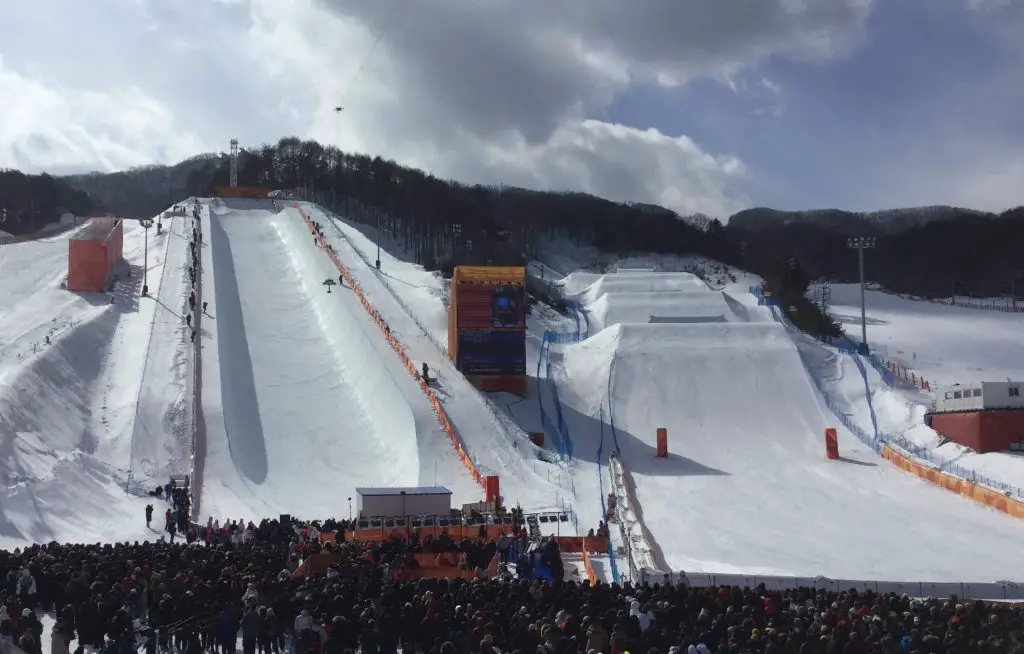
Phoenix Park
The 2018 Winter Olympic & Paralympic Games took place in Pyeongchang, Korea, in February & March 2018. These were the first Winter Olympics in Asia outside of Japan (which has held them twice – Sapporo 1972 and Nagano 1998), and Korea’s second Olympics following the Seoul 1988 Summer Games.
For many skiers & boarders around the world, skiing in Asia is a bit of unknown quantity; while Japan (and especially resorts like Teine & Rusutsu on the northern island of Hokkaido) is famous for its legendary powder snow, skiing on the rest of the continent receives little global attention. That’s about to change though – with Pyeongchang 2018 being followed by Beijing 2022, skiing in (Northeast) Asia is getting more exposure than ever before.
Pyeonchang County, Gangwon Province, Korea
The host ‘city’ in this case was actually neither a city nor a ski resort, but in fact a county. The county of Pyeongchang is a subdivision of the province of Gangwon-do, which is home to the lion’s share of South Korea’s skiing.
Being a county, Pyeongchang covers a pretty large area which includes three ski resorts, all of which hosted events along with a purpose-built course in the neighbouring county of Jeongseon.
The port city of Gangneung is the main population centre near Pyeongchang, and was also a focal point of the Games both in terms of hosting all the ice events, and also for transportation, accommodation & services, etc
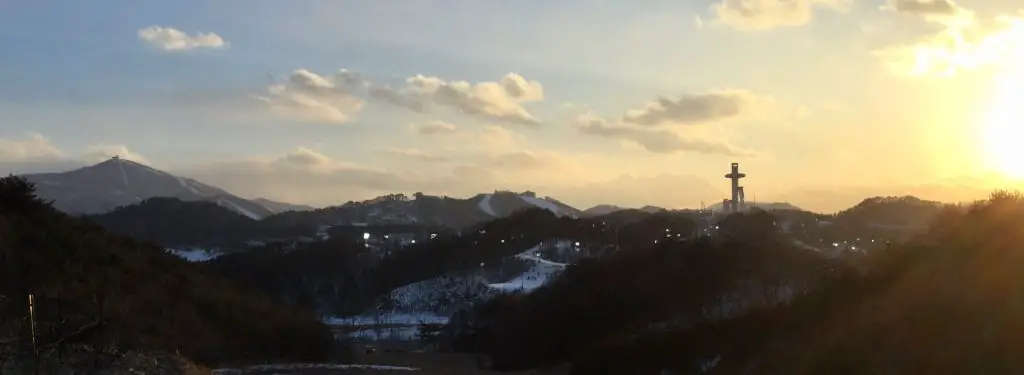
Alpensia and Yongpyong
Pyeongchang 2018 Host Venues
As outlined above, events were held at 4 different ski hills and in the city of Gangneung; the venues at the resorts were labelled the ‘Mountain Cluster’, and the venues in Gangneung were the ‘Coastal Cluster’.
Alpensia Resort is a very small ski hill, but a large resort complete with a ski jump tower, bobsleigh track, and cross-country skiing courses, not to mention several huge hotel / condominium developments and a golf course. The original concept (in 2003) was to provide Korea with the majority of facilities required to host a Winter Olympics, and the plan finally came to fruition after 15 years. Alpensia was also the site of the Olympic Village, and the stadium where the opening & closing ceremonies took place – amazingly the stadium was used just 4 times, for the Olympic & Paralympic opening & closing ceremonies, before being torn down again.
Jeongseon Alpine Centre was built specifically to host the downhill skiing, as at the time of bidding no resort in Korea met the minimum required vertical drop of 800m (Jeongseon has a vertical drop of 825m), and is also slated to be dismantled in order to ‘return the mountain to nature’ (though given they destroyed tens of thousands of trees, that might take a while)
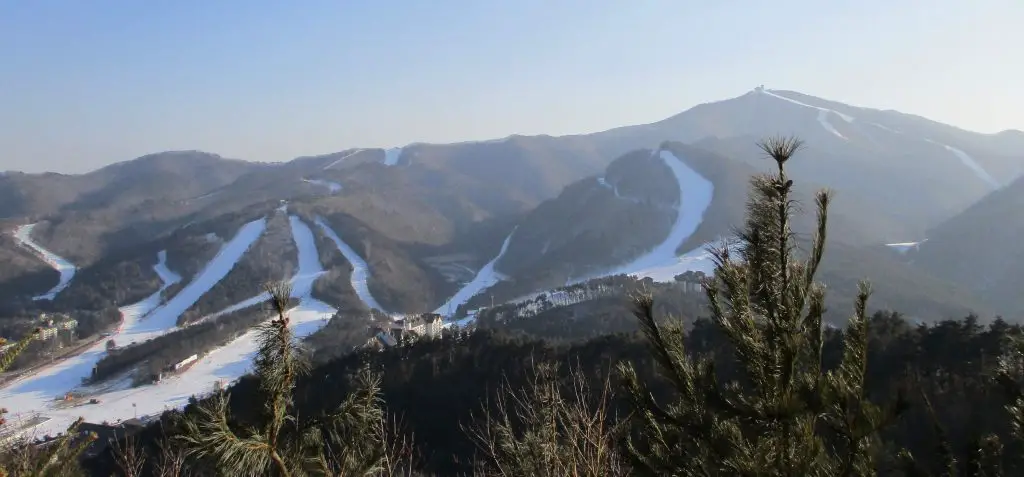
Yongpyong seen from the top of Alpensia
Mountain Cluster
Alpensia: opening & closing ceremonies, ski jumping, big air snowboarding, Nordic combined, cross-country skiing, biathlon, luge, bobsleigh, skeleton bob, para biathlon, para cross-country
Yongpyong: skiing, technical events (slalom & giant slalom)
Jeongseon Alpine Centre: skiing, speed events (downhill, super-G, combined), para skiing, para snowboarding
Bokwang Phoenix Park: freestyle skiing (aerials, moguls, slopestyle, halfpipe, ski cross), snowboarding (slopestyle, halfpipe, parallel giant slalom, board cross)
Click the resort names to see the Snow Guide Korea reviews for each of them. For more details on how they were used for the Olympics, see here
Coastal Cluster
Gangneung: ice hockey, speed skating, figure skating, curling, para hockey, wheelchair curling
For full details on the individual venues in Gangneung, see the official Pyeongchang 2018 website
The Gangneung KTX
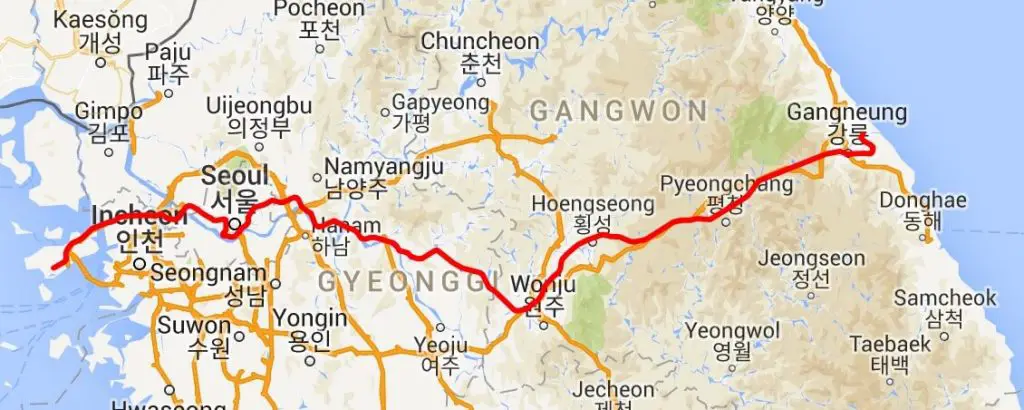
The KTX, Korea’s bullet train system, was extended to Gangneung in time for the Olympics; it started service in December 2017, drastically reducing the travel time from Seoul to the Olympic venues (and several other ski resorts) in Gangwon-do.
See here for more details
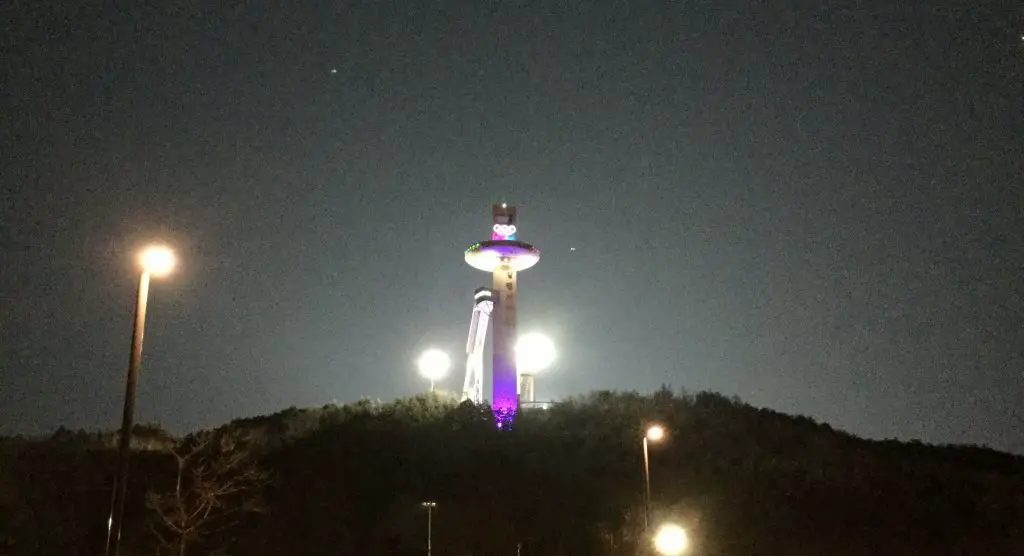
Alpensia ski jump tower
Pyeongchang 2018 Legacy
The Gangneung KTX is arguably the main legacy of the Olympics – it was actually planned a long time ago, but the promise to build it in time for 2018 was a key component of Pyeongchang’s bid. Once Pyeongchang was selected, it provided the impetus to finally build the KTX line to Gangneung; without the Winter Olympics it might very well still be on the drawing board.
The ‘soft’ legacy is a bit harder to pin down; the international exposure should certainly be good for awareness of Korea as a skiing country, but it’s still hard to see that actually translating into it becoming a dream snow destination for riders from Europe, Australia, Canada, etc, in the way that Japan is, as Korea just doesn’t have the same sort of awesome snow. That said, perhaps the Korean ski industry will get a post-Olympic boost of visitors from other Asian countries coming to learn to ski (I’ve certainly heard plenty of Thai and Chinese being spoken on the slopes in Korea).
It’s worth bearing in mind that right from the beginning some 15 years ago this Winter Games was always about the province of Gangwon-do, rather than a matter of national prestige (like Sochi 2014 or Beijing 2022); if it puts Gangwon-do (and, by extension, Korea) on the map as a tourist destination and ski region, that will probably be considered reward enough.
However, there are major concerns about the new facilities ending up as white elephants, and given the fate of some Korean resorts recently (notably O2 Resort and Alps Resort – check out these pics of the latter) there’s some concern about the long-term plans for Alpensia… there’s also an interesting article here about the dubious legacy of using the ski jump stadium as a football ground for Gangwon FC! More thoughts on the future of Korea’s ski industry here


